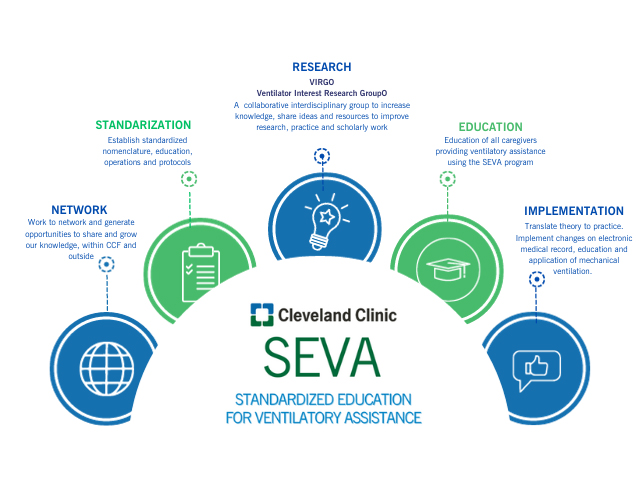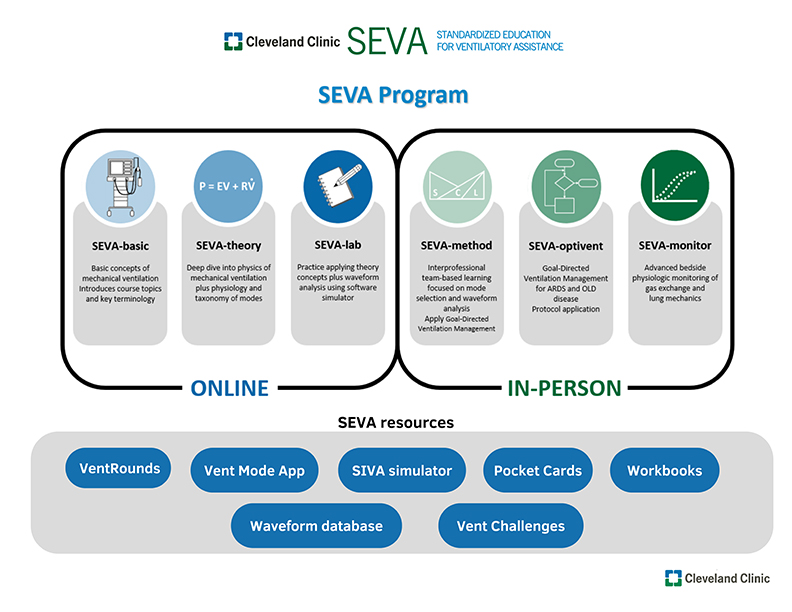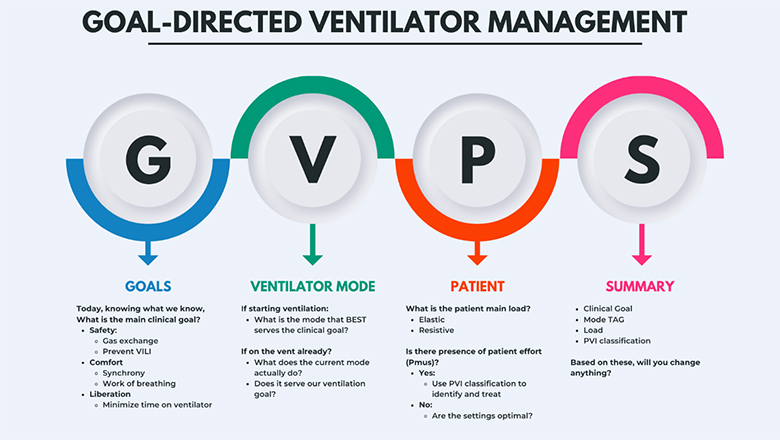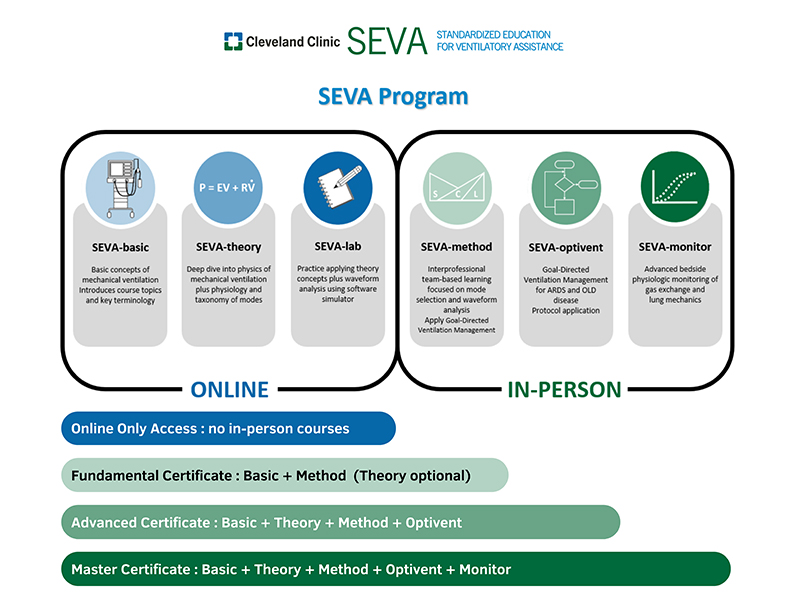Mission
The SEVA mission is to provide a universal and standardized education program in the theory and practice of mechanical ventilation. SEVA uses online and simulation-based instruction that is both self-directed and instructor-led to elevate the competency of healthcare professionals to a mastery level.

Overview
The SEVA program is designed to progressively increase the learner’s level of knowledge of the subject of mechanical ventilation. SEVA is comprised of several educational courses to achieve this. We use different education strategies to accomplish our educational objectives.
- SEVA-basic, SEVA-theory, and SEVA-lab are self-directed, online courses designed to deliver content that is the basis for later courses.
- SEVA-method uses team-based interactive learning, gamification, and practice sessions to extend basic knowledge to apply Goal-Directed Ventilator Management (GDVM).
- SEVA-optivent incorporates team-based learning with patient simulations to apply knowledge in ventilator management of patients with obstructive and restrictive (e.g. ARDS) physiology.
- SEVA-monitor uses skill stations and simulations to teach advanced physiological concepts and monitoring techniques.
- SEVA-VentRounds is an interactive, online, bi-monthly webinar to maintain certification and knowledge retention.

Learners involved in the SEVA program can attain different levels of certification.
- SEVA fundamental level:Any caregiver involved with mechanical ventilation. Learners who would benefit from this level are medical students, residents rotating in the ICU, and nursing or respiratory therapists who may occasionally be called to work with mechanical ventilators. Requisites: SEVA-basic + SEVA-method
- SEVA Advanced level: Caregivers in charge of implementing mechanical ventilation. This would be the minimum level expected for trainees in critical care medicine, advanced practice providers, and respiratory therapists in critical care units. Requisites: SEVA-basic + SEVA-theory + SEVA-lab + SEVA-method + SEVA-optivent
- SEVA Master level:Experienced caregivers in charge of implementing mechanical ventilation. Students at this level learn about disease-specific protocol implementation, advanced physiologic concepts, and monitoring procedures. This level would be expected of mechanical ventilation champions, supervisors, or program directors. This is the required level for critical care physicians-in-training. Requisites: SEVA-basic + SEVA-theory + SEVA-lab + SEVA-method + SEVA-optivent + SEVA-monitor and pass the final test.
Learners are encouraged to achieve the highest level possible. Upon completion of the SEVA program, the learner will be awarded CEUs and a certificate of completion.
For more information, please contact SEVA@CCF.org.
SEVA Resources
Phone application
A free phone app called Ventilator Mode Map is available for download on iPhone and Android. The app is a database of 65 brands of ventilators and 795 mode names classified using the taxonomy of mechanical ventilation. The app is updated periodically, so if you find errors or some ventilators are missing, please message us at SEVA@ccf.org.SEVA checklist
This Goal-Directed Ventilator Management (GDVM) checklist focuses on bedside interpretation of ventilator waveforms and identification of patient-ventilator synchrony problems.The SEVA program trains providers on Goal-Directed Ventilator Management. The framework is highlighted below.

SEVA VentRounds
We offer a bimonthly live conference called SEVA-VentRounds to increase and maintain knowledge. During these 30-minute conferences, we all learn together. We review a key knowledge concept, followed by an analysis of a ventilator waveform using the SEVA method. There is a lot of discussion and learning at every one of these events. Robert Chatburn and Eduardo Mireles-Cabodevila host these interactive events.
SEVA VentRounds is held on the second and fourth Tuesdays at 2 p.m. EST (Cleveland, OH time)
Join for free.
Key articles
- Chatburn RL, El-Khatib M, Mireles-Cabodevila E. A taxonomy for mechanical ventilation: 10 fundamental maxims. Respir Care. 2014;59(11):1747-1763. https://rc.rcjournal.com/content/59/11/1747.short
- Mireles-Cabodevila E, Hatipoglu U, Chatburn RL. A rational framework for selecting modes of ventilation. Respir Care. 2013;58(2):348-366. https://rc.rcjournal.com/content/58/4/e51.2
- Mireles-Cabodevila E, Siuba MT, Chatburn RL. A Taxonomy for patient-ventilator Interactions and a method to read ventilator waveforms. Respir Care. 2021:respcare.09316. https://rc.rcjournal.com/content/67/1/129.short
- Chatburn RL. The Complexities of Mechanical Ventilation: Toppling the Tower of Babel.. Respir Care. 2023 Jun;68(6):796-820. doi: 10.4187/respcare.10828 https://rc.rcjournal.com/content/68/6/796.short
SEVA Training
SEVA training is available year-round, allowing participants to earn the Fundamental Certificate. Additionally, two SEVA Summits are held annually in April and September, where attendees can pursue any of the three SEVA certificates.





